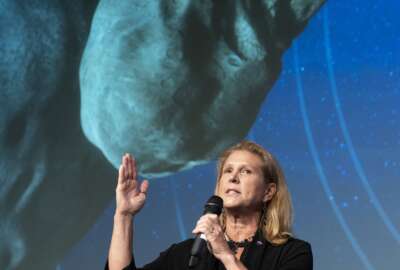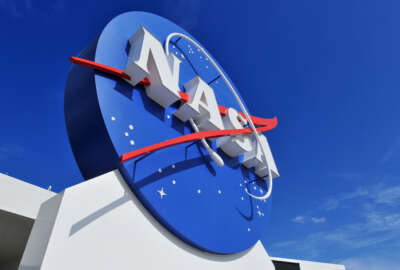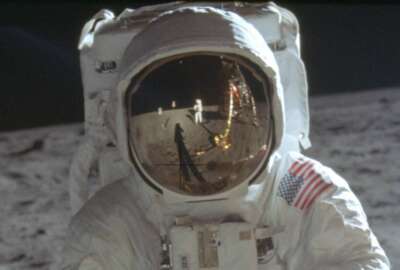Hubbard Radio Washington DC, LLC. All rights reserved. This website is not intended for users located within the European Economic Area.
A NASA challenge grant program brings up 13 promising ideas
Federal News Network's Tom Temin spoke with program deputy executive John Nelson, and acting program executive Mike LaPointe to learn more about NASA's Innovat...
Thirteen academic and corporate thinkers have received awards from NASA, to develop ideas for transforming future missions. It’s part of the NASA Innovative Advanced Concepts Program. Federal News Network’s Tom Temin got more from program deputy executive John Nelson, and acting program executive Mike LaPointe.
Interview Transcript:
Tom Temin The program itself, I guess you call it NIAC, the basic program, NASA Innovative Advanced Concepts program. That is not new, right? You’ve been doing this for a number of years.
Mike LaPointe That’s correct. Actually, it was reconstituted in 2011 as a NASA program. And so, it’s been around for a while. John and I have been, involved with it for the last couple of years. Kind of came on as acting PEO a couple of years back. And John came on, about a year ago last October.
Tom Temin All right. And looks like a challenge grant type of program where you give small amounts of money to a lot of people to develop ideas. Is that basically how it works?
Mike LaPointe It is it’s, actually a three-phase program. And I’ll let John talk about it in more detail. But basically, phase one is, projects that we’ll talk about today is our initial, basically a feasibility study. It’s a nine-month, 175 K, technology development effort. Basically, a study to tell NASA why your idea is a good idea that we should pursue. And then after that, we have, phase two, which is a two-year, 600 K, more of a viability study to put more meat on the bones of the concept. And then phase three, which is very rare. We do basic one of those years, $2 million, two-year effort to really advance the technology. So, John any more you’d like to say about that?
John Nelson Yeah. I’ll just add that while we do have three phases and, you know, phase three does involve some actual technology development. You have to remember, put this in context. This is all very early-stage stuff. So, unlike a lot of technology development programs, we’re not looking at a mission that’s five years out or often even ten years out. We’re looking at capabilities that don’t currently exist. Visionary, truly transformative ideas that may not come into fruition for 20 years or more, and some cases a lot more than 20 years. So that’s why we start with that, that small phase one feasibility concept. We don’t expect all these ideas to work. We’re exploring whether or not the idea has any feasibility at all and is worth further development.
Tom Temin And when you launch a round, just for example, like the one you just awarded, do you focus on a particular area, for example, going to Mars or sustaining human life, or looking back down at the Earth or just anything that might be useful to NASA?
Mike LaPointe That’s exactly right. It’s a wide-open call. We are actually open to anyone in the US, any organization, academia, other government agencies, individuals that, that are registered with sam.gov. But it’s a wide-open call any technology area that’s of interest, for future missions to Mars that they could help us do our job or we’re interested in hearing about.
Tom Temin And how do you spread the word so that the right people will know about it?
Mike LaPointe So that’s a good question. We have a very good network of folks out there that are very applied. And, and they spread the word a lot for us. We also do a solicitation every year, which is also posted in Fed Biz Ops. The synopsis comes out in fed biz ups. A lot of press that we get each time we, we do a phase one call, or phase two call. And that helps us spread the word for us as well. And Kathy Reilly, I believe is still on board is our, strategic outreach and communications manager, and she does an outstanding job of spreading the word for us.
Tom Temin Yeah. Because you don’t want to just be in fed biz ops, because then you’ll get the usual contractors. Fair to say?
Mike LaPointe Absolutely. We have a really good presence on the NASA website. And I should mention to you that we do have a website that lists all of our prior studies, as well as all the key dates and a lot of information about the program. So, your listeners are more than welcome to visit the site.
Tom Temin Any particular exciting technologies that have come to fruition and were deployed by NASA that you can point to in the past.
Mike LaPointe We have, John, you want to take a first shot and I’ll follow up.
John Nelson Sure, sure. So again, we’re focused on really long-term stuff. But that isn’t to say that there can be near-term applications or spinoffs. We’ve actually got one that’s getting ready to fly, hopefully in March scheduled for March. So, the idea was originally a large inflatable reflector balloon that could be used as a telescope. This was from Chris Walker, University of Arizona, and freefall space. Well, he and his students took that idea and shrunk it down to basically a large aperture, antenna for CubeSats. And they’re actually testing that in space. Again, hopefully in March. So that’s one example. But we’ve had many others as well.
Tom Temin Mike.
Mike LaPointe So that’s the one that’s going to help us. And we’ve had a phase three program project called, from Trans Astra to look at, optical mining of asteroids, where they would go out and actually capture an asteroid and use intensely focused, solar energy to mine the volatiles off an asteroid, which, of course, is very far term. But as a spinoff of that, that, asteroid capture process can be used. And they’re looking at it now is, through an SBIR to, for the debris remediation to go and actually capture debris and bring it back into the atmosphere. So, things like that. And one of the things we also point to, as we all know, ingenuity fluid’s last flight on Mars, just recently. But that actually was inspired by a NIAC program. The original NIAC concept in an original NIAC program. We like to take credit for that as well. Where one of our prior PIs did a study on rotorcraft on Mars and on Titan and, the Pi for ingenuity, happened to attend the talk that he was giving realized that, hey, we could do a rotorcraft on a helicopter on Mars, which led to the ingenuity project. So.
Tom Temin Yeah, that was kind of famous. That little, tiny helicopter. I think it just finally gave up the ghost recently. Right?
Mike LaPointe It did just the other day. Yep his last flight, 72 flights. It was pretty impressive.
Tom Temin All right. We’re speaking with Mike LaPointe. He is the acting program executive, and John Nelson is deputy executive for the NASA Innovative Concepts Program. And this latest round, you’ve given 13 awards. What are some of the highlights?
Mike LaPointe John you want to lead us off.
John Nelson Sure. I tell you what, since we were talking about ingenuity, let’s talk about, flight on Mars. So, we just funded a project called Maggie. This is for basically a fixed wing, solar powered plane, vertical takeoff and landing, capable of going. I think it’s something like 180km per flight. That could make it all the way around Mars and give us global access for scientific study. So basically, taking the idea of ingenuity, and just running with it in terms of access to, to the planet, and there have been, studies on fixed wing aircraft on Mars in the past. It’s extremely difficult because of the very thin atmosphere. And most of these concepts were really huge and had a lot of challenges. And certainly, a lot of challenges with this. But the design they proposed has promise and we hope that it shows feasibility.
Tom Temin Yeah. What are the engineers say if you apply enough thrust and control the angle of attack, you can fly a barn door, but maybe not so much on Mars right now. Yeah. All right. So that’s a good one. A couple of others we can hear about.
Mike LaPointe Well, closer to home, we’re funding something called a lightweight, fiber based, radio frequency antenna. These are used for Earth science applications. In this particular case would be used for, looking at, soil moisture. And the reason for that is, you know, once you’re ground saturated, additional runoff causes floods and such as well as on the opposite side of that, you can have a very low soil moisture content with drought. So, this is a way to map, soil moisture content, around the Earth. And the idea here is of a very long, extensive fiber-based array, which is which is new. It’s very difficult to get long extensions in space from, you know, a confined payload. But this is a way to actually use a fiber with an embedded antenna to roll out and get a really long baseline that you can do extremely accurate measurements, for soil moisture, as well as things like sea salinity and other aspects of it. So, earth science application there, going the other extreme, we have, funded a concept to fly out to Alpha Centauri or Proxima Centauri, with a swarm of very small Pico satellites, gram ground-based satellites. You know, this has been looked at through project, Starshot. We use, like, gigawatt class lasers to fly these very, very, very small payloads out, to the nearest star. The is there as you don’t get much communication back. Right. You’re at a very far distance and these things are very, very power limited. But if you fly a swarm you can actually do a coherent signal back. And so, the idea here is you fly a bunch of them, you get out there, you assemble on the way a nice coherent swarm of these little, tiny satellites. And when they get there, they do their sensing, and then they actually put an optical, signal back to Earth that you can pick up with an Earth based telescope.
Tom Temin Well, that one, just to delve in a little bit, Proxima Centauri is that’s the nearest star or something. I mean, how long would that take?
Mike LaPointe So light takes about 4.2 years to get out there and about 4.2 years to get back. So, they’re going to fly these at about 20% the speed of light. So, it’ll take about 20 years to get out there. And then it’ll take about four years to get their signal back.
Tom Temin 20% your speed light’s pretty fast.
Mike LaPointe That’s pretty fast. That’s. Why do you need a 100-gigawatt laser?
Tom Temin You know, really.
John Nelson This is not one that’s 5 or 10 or even 20 years out.
Mike LaPointe Yes, this is a little further out.
Tom Temin So at least you can reasonably assume to live to see the results as opposed to going to somewhere much further away. And. Then one of the awards went to someone from NASA’s Glenn Research Center, Jeff Landis. Something that can survive Venus, which is pretty hot.
Mike LaPointe That’s a really interesting mission. It’s, basically a balloon floating in the atmosphere and an airplane that will go down, pick up a sample, a surface sample, not just an atmospheric sample. Bring it back up to the balloon, which has a rocket attached, transfer the sample to the to the rocket canister, and then fire the rocket back so we can actually get a sample return from Venus. It’s a really interesting way to do this. It’s complex, but it’s fun, which makes it very NIAC(y). And it’ll be the first time we can actually get a sample back from the surface of Venus.
Copyright © 2024 Federal News Network. All rights reserved. This website is not intended for users located within the European Economic Area.
Eric White
Eric White is news anchor and Federal Drive producer at Federal News Network.
Follow @FEDERALNEWSCAST





